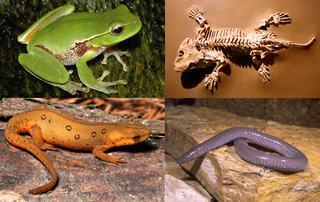
Amphibians are ectothermic, tetrapod vertebrates of the class Amphibia. All living amphibians belong to the group Lissamphibia. They inhabit a wide variety of habitats, with most species living within terrestrial, fossorial, arboreal or freshwater aquatic ecosystems. Thus amphibians typically start out as larvae living in water, but some species have developed behavioural adaptations to bypass this.

Salamanders are a group of amphibians typically characterized by their lizard-like appearance, with slender bodies, blunt snouts, short limbs projecting at right angles to the body, and the presence of a tail in both larvae and adults. All ten extant salamander families are grouped together under the order Urodela. Salamander diversity is highest in eastern North America and most species are found in the Holarctic realm, with some species present in the Neotropical realm.
Amphibious means able to use either land or water. In particular it may refer to:

Herpetology is the branch of zoology concerned with the study of amphibians and reptiles. Birds, which are cladistically included within Reptilia, are traditionally excluded here; the scientific study of birds is the subject of ornithology.

The Lissamphibia is a group of tetrapods that includes all modern amphibians. Lissamphibians consist of three living groups: the Salientia, the Caudata, and the Gymnophiona. A fourth group, the Allocaudata, was moderately successful, spanning 160 million years from the Middle Jurassic to the Early Pleistocene, but became extinct two million years ago.

Since the 1980s, decreases in amphibian populations, including population decline and localized mass extinctions, have been observed in locations all over the world. These declines are known as one of the most critical threats to global biodiversity.

Chytridiomycosis is an infectious disease in amphibians, caused by the chytrid fungi Batrachochytrium dendrobatidis and Batrachochytrium salamandrivorans. Chytridiomycosis has been linked to dramatic population declines or extinctions of amphibian species in western North America, Central America, South America, eastern Australia, east Africa (Tanzania), and Dominica and Montserrat in the Caribbean. Much of the New World is also at risk of the disease arriving within the coming years. The fungus is capable of causing sporadic deaths in some amphibian populations and 100% mortality in others. No effective measure is known for control of the disease in wild populations. Various clinical signs are seen by individuals affected by the disease. A number of options are possible for controlling this disease-causing fungus, though none has proved to be feasible on a large scale. The disease has been proposed as a contributing factor to a global decline in amphibian populations that apparently has affected about 30% of the amphibian species of the world. Some research found evidence insufficient for linking chytrid fungi and chytridiomycosis to global amphibian declines, but more recent research establishes a connection and attributes the spread of the disease to its transmission through international trade routes into native ecosystems.

The white-lipped tree frog is found in Australia and is the world's largest tree frog. Other common names include the New Guinea treefrog, giant tree frog, and Australian giant treefrog.
Sicilian refers to the autonomous Italian island of Sicily.

The gray treefrog is a species of small arboreal holarctic tree frog native to much of the eastern United States and southeastern Canada.

Amphibian Man is a 1962 Soviet science fiction romance film starring Vladimir Korenev and directed by Vladimir Chebotaryov and Gennadi Kazansky. The film stars Vladimir Korenev and Anastasiya Vertinskaya in the lead roles.

Gerobatrachus is an extinct genus of amphibamid temnospondyl that lived in the Early Permian, approximately 290 million years ago (Ma), in the area that is now Baylor County, Texas. When it was first described in 2008, Gerobatrachus was announced to be the closest relative of Batrachia, the group that includes modern frogs and salamanders. It possesses a mixture of characteristics from both groups, including a large frog-like head and a salamander-like tail. These features have led to it being dubbed a frogamander by the press. Some more recent studies place Gerobatrachus as the closest relative of Lissamphibia, the group that contains all modern amphibians including frogs, salamanders, and caecilians, or place modern amphibians far from Gerobatrachus within a group called Lepospondyli.
Anatoli Ivanov may refer to:
The Ichthyander Project was the first project involving underwater habitats in the Soviet Union in 1960s.

Pain is an aversive sensation and feeling associated with actual, or potential, tissue damage. It is widely accepted by a broad spectrum of scientists and philosophers that non-human animals can perceive pain, including pain in amphibians.

Vladimir Borisovich Korenev was a Soviet and Russian film and theatre actor and teacher, known for The Amphibian Man (1962). He was awarded People's Artist of Russia in 1998.

The Shape of Water is a 2017 American romantic fantasy film directed by Guillermo del Toro and written by del Toro and Vanessa Taylor. It stars Sally Hawkins, Michael Shannon, Richard Jenkins, Doug Jones, Michael Stuhlbarg, and Octavia Spencer. Set in 1962 Baltimore, Maryland, the film follows a mute cleaner at a high-security government laboratory who falls in love with a captured humanoid amphibian creature, and decides to help him escape from death at the hands of an evil colonel. Filming took place on location in Ontario, Canada, from August to November 2016.

Feels Good Man is a 2020 American documentary film about the Internet meme Pepe the Frog. Marking the directorial debut of Arthur Jones, the film stars artist Matt Furie, the creator of Pepe. The film follows Furie as he struggles to reclaim control of Pepe from members of the alt-right who have co-opted the image for their own purposes. The film premiered at the 2020 Sundance Film Festival and won a U.S. Documentary Special Jury Award for Emerging Filmmaker. It was also nominated in the U.S. Documentary Competition at Sundance.













